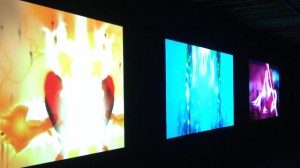As a part of its “On the Go” series during its multi-year construction hiatus, SFMOMA headed south this month to show off some of its early 20th century paintings, sculptures, drawings and prints at the Cantor Arts Center at Stanford University. Coincidentally, the institution also mounted an equally traditional (say, circa 1981) “project” in the affluent Silicon Valley hamlet of Los Altos. Both continue through March of 2014.
Organized by a number of SFMOMA, Cantor and Stanford art professionals and professors, as well as a few Stanford students, the Cantor show, Flesh and Metal: Body and Machine in Early 20th-Century Art, sounds promising, but the inclusion of works that are only concerned with the Flesh alongside those that are preoccupied with Metal turns what should have been a focused exercise into a sweeping grab bag. “Taken together,” we’re told on the Cantor’s website, “the works offer a fresh view of how artists negotiated the terrain between the mechanical and the bodily — two oppositional yet inextricably bound forces — to produce a wide range of imagery responding to the complexity of modern experience.” Giving definition to “terrain” (putting flesh on the metal, one might say), SFMOMA’s site reveals that the show considers how modern artists “reconciled the impersonal world of the mechanical with the uncontrollable realm of the human psyche” to produce “a wide range of” etcetera, etcetera, etcetera.
The resulting range is a good deal too wide. While I enjoyed seeing the Margaret Bourke-White photograph of RCA speakers taken in 1935 and the Salvador Dali painting of surreal genitalia from 1928, I’m not sure what the two have in common, nor how either has negotiated or reconciled anything within or beyond their own frames. Should we be impressed that both were executed within the same half-century? Is it really so unusual that one work deals exclusively with machines while the other is focused just as exclusively on flesh? I’m no art professor, but the really interesting thing about artworks that flirt with a concept like “Flesh and Metal” is when those two come together in a single work of art, not when they happen to be included in the same exhibition.

Raoul Ubac, Penthésilée, 1937. Collection SFMOMA, gift of Robert Miller.
You can see the potential of the show in the artworks that actually meet the terms of its title. There is, of course, Alexander Calder, whose clever metal sculpture from 1940 features an s-curve armature, suggesting a playfully abstracted torso. Similarly, there’s the smart little Raoul Ubac photograph from 1937, in which the hard machinery secreted within a pair of nudes has been exposed. Right next to that efficient encapsulation of the exhibition’s premise is another work from the same year by Hans Bellmer. And I can even see a case being made for the Yves Tanguy from 1939, thanks to the wires connecting the artist’s vaguely biomorphic shapes, as if to send positive and negative electrical charges through them, forcing flesh to behave as machine. But don’t tell me László Moholy-Nagy’s 1923 painting depicting a number of geometric elements presented in isometric projection indicate a nexus of the human and mechanical realms simply because the great man’s hand wielded the brush.





